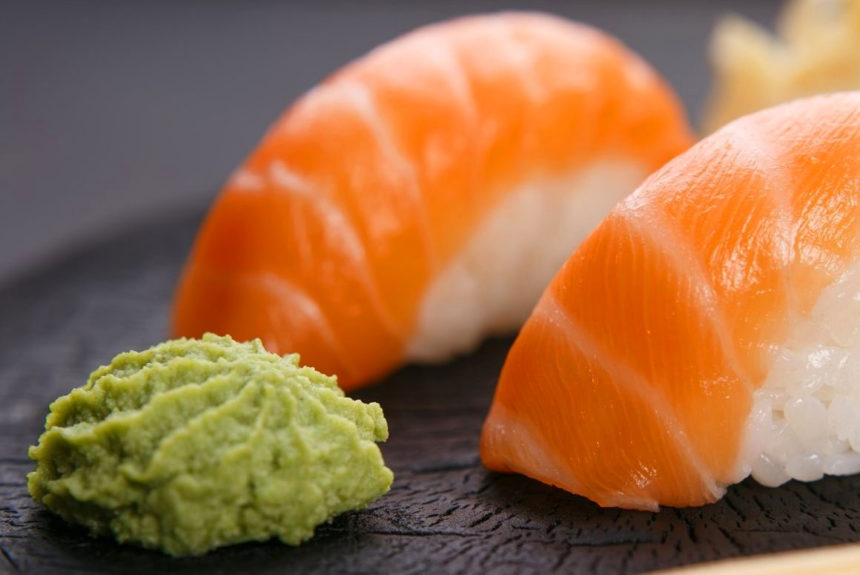Wasabi and sushi go together like white on rice. One bite, and that delicious pea-green paste stings the nasal cavity with its searing heat for just a few seconds — a wonderful combination of pain and pleasure. Yet the flavor and spiciness are different from that of a hot pepper — since it’s not oil based, wasabi doesn’t usually leave you reaching for a glass of water, though it may clear your sinuses and make your eyes water.
You can use wasabi in other ways besides topping sushi, of course. Recipes abound online for wasabi mayonnaise, mashed potatoes, marinades and more. But how much do you really know about this marvelous Asian condiment? Read on for some fun facts to share with your fellow diners the next time wasabi makes it way to your dinner plate.
1. The wasabi plant is hard to grow.
:max_bytes(150000):strip_icc():format(webp)/__opt__aboutcom__coeus__resources__content_migration__mnn__images__2016__09__wasabi-farm-8d3981e0297c444e9d67720d918b3012.jpg)
The wasabi plant (Wasabia japonica), which dates back to the 10th century in Japan, is difficult to cultivate. It grows in cool, shady mountain stream beds mainly in Japan, but growers have popped up in Taiwan, China, the United States and other countries, according to Real Wasabi, a company that grows and imports wasabi. The plant thrives between 46 and 70 degrees but can’t tolerate direct sunlight. It’s so hard to grow wasabi that supply has become scarce as demand has increased, and wasabi has become quite expensive. Which brings us to this next fact…
2. What you buy in the store probably isn’t real wasabi.
:max_bytes(150000):strip_icc():format(webp)/__opt__aboutcom__coeus__resources__content_migration__mnn__images__2016__09__wasabi-ingredients-25a730aa98f541fdb47edc24138b9899.jpg)
Because of the scarcity, most of the wasabi pastes and powders you find at the supermarket contain barely any real wasabi, if they have any at all. Instead, the flavor is created with a combination of horseradish, Chinese mustard, food coloring and other ingredients. Check the ingredient list, and if the first ingredient isn’t wasabi or wasabi japonica, it’s not real wasabi. Specialty markets and fine dining establishments are likely to carry the real deal.
3. It’s a member of the cabbage family.
:max_bytes(150000):strip_icc():format(webp)/__opt__aboutcom__coeus__resources__content_migration__mnn__images__2016__09__wasabi-root-51ece4cdc981482cb29512f45fa5c7ba.jpg)
Wasabi is a member of the Brassicaceae family, which includes cabbage, horseradish and mustard. Wasabi is sometimes called Japanese horseradish, but that’s not correct, as horseradish is a separate plant.
It grows submerged, and while the portion of the plant that grows underwater looks like a root, it’s not. It’s actually the stem.
4. Wasabi is a nutritional powerhouse.
:max_bytes(150000):strip_icc():format(webp)/__opt__aboutcom__coeus__resources__content_migration__mnn__images__2016__09__wasabi-in-bowl-898a63445774479ebe6ff3046fe15fae.jpg)
Since we use wasabi in small amounts, we don’t get a big nutritional benefit from it. However, this little plant still packs a healthy punch, according to Dr. Joseph Mercola, an osteopathic physician. Wasabi has anti-inflammatory and antimicrobial properties, and it contains potassium, calcium and vitamin C. And according to Chemical & Engineering News magazine, wasabi’s isothiocyanates (a family of organic compounds found in some herbs) are thought to alleviate symptoms in a number of disorders, including allergies, asthma, cancer, inflammation and neurodegenerative diseases.
Also, wasabi contains allyl isothiocyanate, a colorless oil that gives the plant its pungent taste. But allyl isothiocyanate is also a potent insecticide and bacteriocide that helps combat potential food bugs. So pairing sashimi with wasabi isn’t only a tasty idea, it’s a smart one, too.
5. Real wasabi loses its flavor quickly.
:max_bytes(150000):strip_icc():format(webp)/__opt__aboutcom__coeus__resources__content_migration__mnn__images__2016__09__grating-wasabi-29457c296b074e12983138d1f88842d0.jpg)
Once a real wasabi paste is made, it loses its zing in about 15 minutes if left uncovered.
The traditional way to grate wasabi is with a sharkskin grater, or an oroshi, which has the texture of fine sandpaper. Pro tip: Because the flavor and heat fade so fast, it’s best to grate it as you need it.

